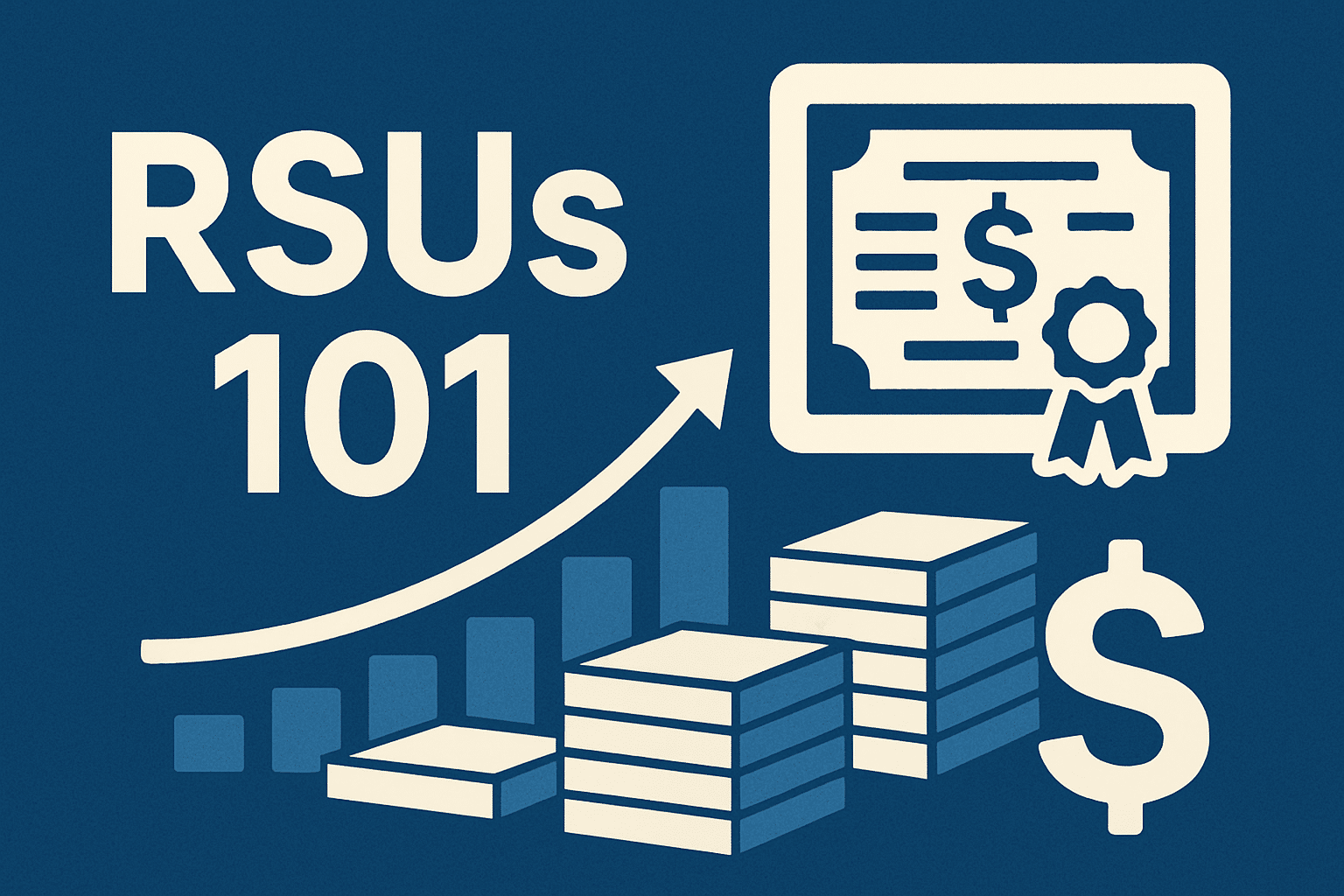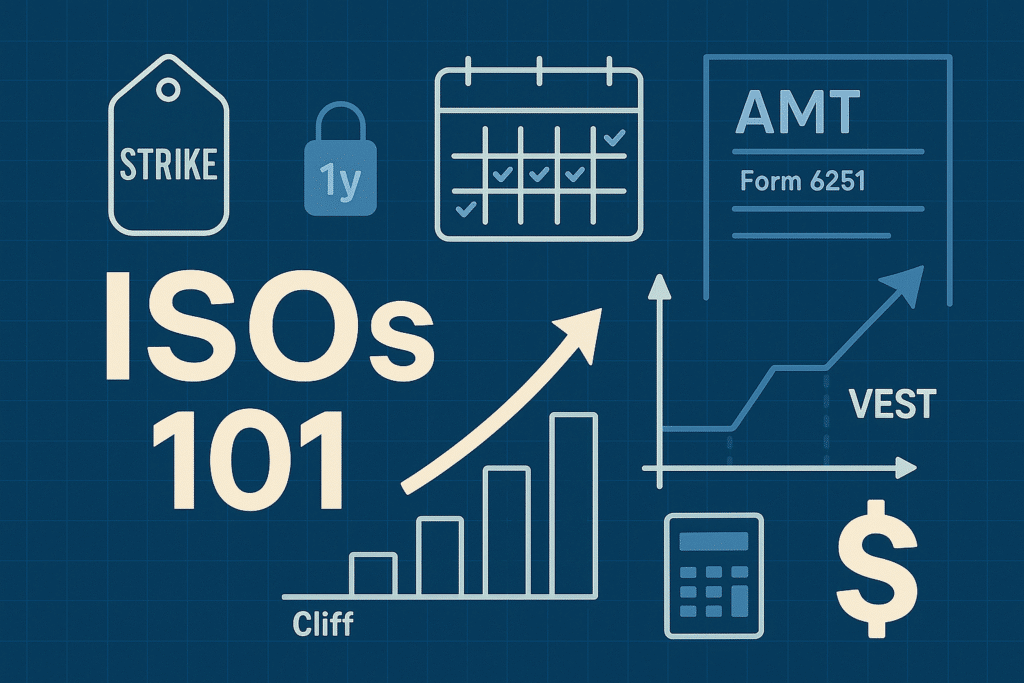If part of your pay shows up as “RSUs,” you’re being paid in company stock that vests over time. That can be a powerful wealth builder, but it also changes your taxes, your cash flow, and your investment mix in ways a normal paycheck does not.
This guide breaks down how RSUs work, how they’re taxed, and the choices you’ll face when shares vest. We’ll keep it practical so you can turn a confusing benefit into a clear plan.
What Are RSUs, in Plain English?
Restricted stock units, or RSUs, represent a future grant of company shares that your employer agrees to deliver on a set timeline. Typically, you only become entitled to those shares if you stay with the company long enough for them to “vest.” In practice, RSUs function like stock-based compensation that’s postponed—you don’t pay anything up front, and no actual shares land in your account until the vesting date arrives.
When RSUs vest, the company delivers shares to your brokerage account (or cash based on the stock price on the vest date, in some plans). That vesting moment is also the tax event. The fair market value of the shares counts as W-2 income, just like a bonus. You may sell some shares right away to cover taxes or keep them for potential growth, but taxes are due regardless.
How RSUs Vest and Deliver Shares
RSU plans follow different rules, and those rules drive when you receive shares and when you owe tax. Before you plan, it helps to know which levers your company uses and how they interact. Here are the common structures you will see:
Time-Based Vesting (Graded): A common example of a vesting schedule is 25% per year over four years. The vest dates are typically the same day and month, and provided to you in advance. Another example is a monthly or quarterly vesting date schedule with or without a 12-month wait (or cliff). You receive a slice of shares each period as it vests, which spreads both share delivery and taxable income across the schedule.
Cliff Vesting: Nothing vests until a specified date. After the cliff, shares may vest all at once or continue monthly or quarterly. This structure concentrates tax and liquidity decisions into fewer, larger events.
Performance or Milestone Triggers: Shares vest only if company goals (revenue, EBITDA, or product milestones) are met. If targets are missed, some or all RSUs are forfeited, which ties your compensation directly to outcomes beyond simple tenure.This is less common in general, and is provided mostly to higher-level executives.
Double-Trigger RSUs (Common Pre-IPO): You must meet a service trigger (time employed) and a liquidity trigger (IPO, acquisition, or board-approved liquidity event). Shares are not delivered — and tax is not due — until both triggers occur, which can delay income for years. This is more common with private companies.
Settlement Method: Your employer may “net settle,” withholding a portion of shares to cover taxes, or use a sell-to-cover through the broker. Either way, the number of net shares you receive will be lower than the number that vested because some value is set aside for tax withholding.
Please Note: RSUs don’t qualify for an 83(b) election. An 83(b) election is a special tax choice that lets you pay income tax on the value of certain equity (like restricted stock awards or early-exercised options) right when it’s granted, instead of waiting until it vests. Because RSUs aren’t considered “owned” until they vest, this election isn’t available for them.
Taxes on RSUs — When and How You Pay
RSUs are taxed when they vest (and settle). The fair market value of the shares at vest is treated as supplemental wages and added to your W-2 income. When RSUs vest, your company takes out federal and state income taxes along with payroll deductions—covering Social Security (up to the annual wage cap) and Medicare. Companies usually follow IRS supplemental wage rules, which often use flat rates that may not match your personal marginal bracket.
Because withholding may be lower than your marginal tax bracket rate, we often hear complaints about a surprise tax bill from clients. You can address the gap by increasing withholding on regular paychecks or making quarterly tax payments directly to the IRS. Planning ahead avoids penalties and helps you avoid cash-flow hiccups.
Your cost basis for each vested share equals the price per share delivered to you at vest. If you sell immediately at roughly the same price, there is little or no capital gain. If you hold and the stock rises, the later profit is a capital gain (short-term if held one year or less; long-term if held more than one year). If the share price drops and you sell at a loss, that loss can be applied against other capital gains and, within certain limits, against ordinary income as well.
Please Note: High earners may also face the 3.8% net investment income tax (NIIT) on capital gains from shares held and sold later. State and local taxes can apply at vesting and again on future gains, depending on where you live and work. Don’t just assume your state follows federal rules on short-term and long-term capital gains tax rates. Some state rates are much higher, and some employ a flat rate regardless of how long you’ve held the asset.
RSUs vs. Other Stock-Based Plans — High-Level Comparisons
It’s easy to confuse RSUs with other forms of stock-based compensation. Each type has its own tax rules and planning timelines. Here’s a quick snapshot comparison to keep the terms and rules straight:
RSUs (Restricted Stock Units): You don’t purchase shares. They’re delivered when they vest and taxed as ordinary wages at that time. The structure is straightforward but creates concentration risk and forces a sell-or-hold decision every time they vest.
RSAs (Restricted Stock Awards): Actual shares are granted upfront but remain subject to forfeiture until vesting. Unlike RSUs, RSAs may permit an 83(b) election, moving taxation to the grant date and allowing more future growth to be taxed as capital gains.
ISOs (Incentive Stock Options): You’re granted the ability to purchase company stock at a set price. If you meet certain holding periods, the spread and gains can be considered long-term capital gain (as opposed to wage income), but exercising and holding can trigger AMT (Alternative Minimum Tax), which requires careful modeling.
NSOs (Non-Qualified Stock Options): You’re granted the ability to purchase company stock at a set price. The spread when exercised is taxed as wages, and any later appreciation is taxed as capital gains. Additionally, with NSOs, there is no AMT exposure.
Employee Stock Purchase Plan (ESPP): You set aside income in order to acquire stock after an offering period at a discounted rate, with the cost taken directly from your paycheck. Taxes depend on holding periods, and the discount is often treated as ordinary income while additional growth can qualify for capital gains tax treatment.
RSU Selling Strategy: Hold or Sell at Vest
There is no universal rule for selling RSUs. Your choice should fit your overall financial goals, risk tolerance, and tax picture (in that order). That said, the following frameworks may help you weigh your options in advance:
Sell ASAP: This approach turns the stock into cash that you can use as if you received a higher paycheck. This puts the onus on you to use the proceeds however you deem optimal, rather than relying on the company’s stock price to deliver results following your vesting dates.
Sell to Fund Goals: You sell whatever portion is available to fund near-term expenses or milestones (e.g. taxes, a down payment, or a debt payoff) and keep a measured slice for long-term growth. This recognizes both cash demands and potential upside.
Sell-to-Cover Only: You sell just enough shares to cover taxes and keep the remainder. This keeps some upside potential while acknowledging the immediate tax bill, but it also leaves you exposed to volatility in a single stock.
Hold with Guardrails: You keep shares but set rules: a price target, a trailing stop, a time limit, or a maximum employer-stock allocation. Writing these rules down helps you act consistently rather than reacting emotionally.
Use a 10b5-1 Plan (If You’re an Insider): You pre-schedule sell trades to avoid blackout windows and insider-trading risk. This turns concentration reduction into a steady process instead of a scramble during open windows.
Other Planning Moves That Add Real Value
RSUs are more than just extra shares in your account — they can be a key tool in shaping your financial future if you approach them with a plan. Beyond the immediate tax and sell-or-hold decisions, here are some additional ways to put your RSUs to work for you:
Match vests to life milestones: Your RSUs can become a funding source for major goals such as buying a home, paying off student loans, or setting aside money for a child’s education. Mapping each vesting date to a specific goal can help you use the proceeds intentionally instead of letting them sit idle or get swept away by lifestyle spending.
Think about estate and legacy planning: If you expect to hold shares long-term, it may make sense to consider how RSUs fit into your estate plan. Shares you still own at death are typically passed on to heirs, who may benefit from a step-up in cost basis at the time of death. If leaving assets to loved ones or charities is part of your vision, RSUs can play a role in that plan.
Review liquidity and risk exposure regularly: Even after you’ve decided whether to sell or hold, check in on how much of your wealth is concentrated in company stock compared to your other assets. You may need to gradually reduce exposure or redirect proceeds into diversified investments to better support your financial stability over time.
Coordinate with your broader compensation: If you receive bonuses, stock options, or participate in a 401(k), consider how RSUs complement those benefits. Aligning these pieces creates a smoother income stream and can help you grow long-term wealth without overcommitting to one company or one type of asset.
Private-Company RSUs and Double-Trigger Grants
At private companies, many RSUs do not deliver shares — or trigger tax — until two things happen: you satisfy service vesting and the company experiences a liquidity event (IPO, acquisition, or a board-approved tender offer). Until the second trigger, you may see “units” on paper without tradable shares or taxable income.
When a double-trigger event arrives, many things can hit at once: a large number of RSUs settle, W-2 income spikes, and sales may be subject to lock-ups or staged release schedules. Withholding can also be significant; some companies withhold at the maximum supplemental rate to reduce the risk of under-withholding. If you expect to be cash-constrained, model the number of net-delivered shares and confirm whether a same-day sale will be available as windows open.
Tender offers can provide partial liquidity before or after an IPO. These events raise the same questions as public-company vests — how much to sell, how to manage taxes, and how to keep your allocation in check — but the timelines are tighter. A written plan helps you act quickly when trading windows are brief.
Common RSU Pitfalls to Avoid
A few frequent mistakes have the ability to erode more value than market swings do. Keep these on your radar when dealing with RSUs:
Letting RSUs Dictate Your Risk: Major vests can push your portfolio off target without you noticing. Rebalance (or at least review) after each vest so the stock does not derail your plan.
Treating Withholding as Final: Flat rates are often a starting point. If you are in a higher bracket, add withholding or schedule estimated tax payments to avoid penalties and surprises.
Forgetting Trading Windows: If you need cash during a blackout, you may be stuck. A 10b5-1 plan can keep the diversification process moving even when you are busy.
Losing Track of Basis: Incorrect cost basis reporting can create more tax than you actually owe. Keep a simple log of vest dates, share counts, and per-share values. Do not blindly file your tax return without double-checking the capital gains realized of all your investments – especially your company’s stock.
Confusing RSUs With RSAs or Options: RSUs do not allow 83(b) and do not require cash to exercise.
Restricted Stock Unit (RSU) FAQs
Why do some employees prefer RSUs over other forms of compensation?
Many employees favor RSUs since they’re easier to understand and manage compared to stock options. They have no exercise price—a set cost per share—before you own the stock. They also can’t trigger an alternative minimum tax (AMT), which can create unexpected tax bills. With RSUs, you won’t have to worry about whether or not the current market price is above the exercise price—known as being “in the money.”
Are RSUs taxed when they are granted or when they vest?
They are taxed when they vest. The fair market value when they vest is W-2 income. Grant dates do not trigger tax for RSUs.
Can I file an 83(b) election for RSUs?
No. 83(b) elections apply to RSAs and some early-exercise options, not RSUs.
What happens if I leave the company before my RSUs vest?
RSUs that aren’t vested are usually forfeited. Some plans accelerate vesting for events like death, disability, or termination, so it is worth checking your grant agreement.
Do RSUs affect my 401(k) contributions?
RSU income increases your W-2 wages, but many plans do not treat vesting income as deferrable compensation for 401(k) purposes. Your regular paycheck deferrals continue as usual.
How do dividends work with RSUs?
Unvested RSUs generally do not receive dividends. Some plans pay dividend equivalents in cash when shares vest, and those payments are taxed as wages. Once shares are delivered, you receive dividends like any shareholder.
What if my company withholds too few (or too many) shares?
Withholding follows IRS rules and plan design. If withholding ends up below your bracket, make estimated payments or adjust payroll withholding; if it is too high, you’ll likely get a refund.
Do blackout windows stop my RSUs from vesting?
No. Vesting and delivery can occur during a blackout, but you may be restricted from selling until the window opens. A 10b5-1 plan can pre-schedule sales for permitted periods.
What is a good rule of thumb for selling vs. holding?
If employer stock would exceed your target allocation after a vest, trim it back. Many people sell at least enough to cover taxes and near-term goals, then keep a capped portion for long-term upside.
Do RSUs trigger AMT like ISOs can?
They do not. RSUs are taxed as regular wages when they vest. AMT concerns are tied to ISOs when exercised and held.
We Can Help You Make the Most of Your RSUs
RSUs may look simple on paper, but the real challenge comes when they intersect with the rest of your financial life. Vesting schedules collide with trading windows, withholding may not match your true bracket, and your portfolio can tilt toward one stock faster than you expect. Without a plan, it is easy to take on more risk than you intended or face a surprise tax bill.
That is where we come in. We’ll help you line up vesting dates, tax moves, and portfolio decisions so they work together. Whether you want to trim exposure right away or keep a measured slice for long-term upside, we will set guardrails, model trade-offs, and keep your broader goals front and center. If you already work with a CPA or attorney, we will coordinate. If you do not, we will help you find the right partner.
We also go beyond just the tax and investment angles. Many people use RSUs to fund retirement savings, a future home purchase, education expenses, or even to launch a new business. We’ll work with you to connect each vesting event to what you want most, so your equity compensation becomes a tool for building the life you envision — not just another line item on your pay stub.
If you’re ready to talk more about your RSU strategy, please use the button below to schedule a complimentary consultation call with our team.












